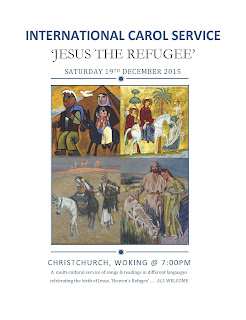-->
Celebrated Christian author to visit the UK
Dr David Garrison,
author of the acclaimed book A Wind in the House of Islam will be taking part in a speaking tour of the
UK in June. The ‘Hope for Muslims’ tour aims to be a catalyst for more prayer
and more action on reaching out to our Muslim neighbours.
In his book, Dr David
Garrison concludes that never in the history of Muslim/Christian interaction have
we seen the response to the Gospel we are seeing today. It is a story of how, in answer to
prayer and in response to a religion that is becoming increasingly divided,
thousands of Muslims are choosing to become followers of Jesus. Dr Garrison
tells us that today, in more than 70 separate locations in 29 nations new
movements of Muslim-background followers of Christ are taking place.
Dr Garrison defines a
movement to Christ to be at least 100 new churches started or 1,000 baptisms
that occur over a 20-year period in one people group. His research
involved seeing many of the churches for himself and systematically
interviewing more than 1,000 Muslim background believers from the groups he
details.
Dr Garrison will speak
at venues in Scotland, Northern Ireland, moving down through England, finishing
in the London area on 21st June. The tour will end as the 30 Days of Prayer for
the Muslim World begins, coinciding as always with the Muslim fast of Ramadan.
This prayer movement, which began in 1993, has been one of the keys to the move
of God we are seeing. We want to see the wind of God's Spirit continue to blow
right across the Muslim world, including right here in the UK.
Dr Garrison’s book, A Wind in the House
of Islam will be available for sale
during the tour and from selected Christian bookshops around the UK.
Hope for Muslims is an
initiative of a wide range of mission agencies of the Global Connections
network.
For more information
contact:
E:
abower@globalconnections.org.uk
T: 01926 487755
Further information
About the author
For nearly 30 years Dr
David Garrison has been a missionary pioneer with the Southern Baptist
International Mission Board. His faith journey has led him to study a dozen
languages and travel through 100 countries.
Dr Garrison currently
lives in Colorado with his wife of 35 years, Sonia, and two of their four
children, where he serves as the Southern Baptist International Mission Board’s
Global Strategist for Evangelical Advance.
About the book
There are nine rooms
in the House of Islam. A wind is blowing through every one of them.
A Wind in the House of Islam explores
the stories of more than 1,000 Muslim-background followers of Jesus Christ from
each of the nine rooms in the House of Islam. Join Dr Garrison in this amazing
journey of discovery, tracing the work of the Holy Spirit as He blows through
the House of Islam.
Dr Garrison travelled
a 250,000 miles into every corner of the Muslim world collecting interviews
from more than a thousand former Muslims who have given their lives to Jesus
Christ. These Muslim-background believers were interviewed because they were
part of larger movements of Muslims to Christ in their communities. He asked
them, “What is your story? What did God use to bring you to faith in Jesus Christ?”
Along the way, Dr Garrison discovered that we are in the middle of the greatest
turning of Muslims to Christ in history. These historic movements are taking
place all across the Muslim world, from West Africa to Indonesia.
Book review
A Wind in the House of Islam by David Garrison
This book is inspirational. It contains all the serious research of
an academic treatise, yet is easy reading and faith building. A Wind in the
House of Islam tells the remarkable story of God's activity in drawing
millions of Muslims to faith in Christ. This mass movement of the 21st
Century (just 12 years!) is set against the historical failure of the church's
mission in the previous centuries. Given that Islam is the last major
people group to respond to the Gospel, these stories and events are highly
significant. Each of nine major regions of
Muslim-dominated countries is examined and while the response to Christ is
proportionally higher in some than others, every region is telling the same
basic story. Dr Garrison has given us a window into a world many of us knew
little about, have been troubled by and have judged by the media's fear-ridden
headlines. Behind those headlines we learn that God is powerfully at work!
I commend the book: it will illuminate your understanding, warm your
heart, raise your spirits and encourage your prayers.
Reviewed by Andrew Kane - Teaching Pastor, Christ Church Woking
Supporting resource
30 days of Prayer
for the Muslim World is a prayer guide for those wishing to pray for
Muslims. The 30 days of prayer
coincide with the Muslim fast of Ramadan.
For further information or to order a prayer
guide, please visit www.30-days.net









